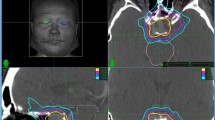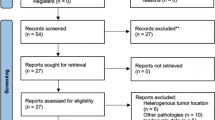Abstract
Several studies have reported the efficacy and safety of hypofractionated stereotactic radiosurgery (hSRS) in the treatment of benign perioptic tumors. This study went further and evaluated the feasibility of hSRS in the treatment of those causing compressive cranial neuropathies (CCNs) among perioptic tumors with special consideration of functional improvement. Twenty-six patients with CCNs (CN II = 19; CN III/IV/VI = 9; CN V = 3) caused by perioptic tumors underwent hSRS between 2011 and 2015. hSRS was delivered in five fractions with a median marginal dose of 27.8 Gy (≈14 Gy in a single fraction, assuming an α/β of three) to a tumor volume of 8.2 ± 8.3 cm3. All tumors except one shrank after treatment, with a mean volume decrease of 35 % (range 4−84 %) during the mean follow-up period of 20 months. In 19 patients (38 eyes) with compressive optic neuropathy, vision improved in 55.3 % of eyes (n = 21), was unchanged in 36.8 % (n = 14), and worsened in 7.9 % (n = 3) (2.6 % after excluding two eyes deteriorated due to transient tumor swelling). A higher conformity index (p = 0.034) and volume of the optic apparatus receiving >23.0 Gy (p = 0.019) were associated with greater tumor shrinkage. A greater decrease in tumor volume (p = 0.035) was associated with a better improvement in vision. Ophthalmoplegia and facial hypesthesia improved in six of nine (66.7 %) and three of three (100 %) patients, respectively. There was no newly developed neurological deficit. Decompressive SRS for benign perioptic tumors causing CCN is feasible using hypofractionation, representing a useful alternative to microsurgical resection.



Similar content being viewed by others
References
Bassiouni H, Asgari S, Stolke D (2006) Tuberculum sellae meningiomas: functional outcome in a consecutive series treated microsurgically. Surg Neurol 66:37–44. doi:10.1016/j.surneu.2005.11.059 (discussion 44–35)
Chicani CF, Miller NR (2003) Visual outcome in surgically treated suprasellar meningiomas. J Neuroophthalmol 23:3–10. doi:10.1097/00041327-200303000-00002
Lee JH, Jeun SS, Evans J, Kosmorsky G (2001) Surgical management of clinoidal meningiomas. Neurosurgery 48:1012–1019 (discussion 1019–1021)
Pamir MN, Belirgen M, Ozduman K, Kilic T, Ozek M (2008) Anterior clinoidal meningiomas: analysis of 43 consecutive surgically treated cases. Acta Neurochir (Wien) 150:625–635. doi:10.1007/s00701-008-1594-x (discussion 635–626)
Schick U, Hassler W (2005) Surgical management of tuberculum sellae meningiomas: involvement of the optic canal and visual outcome. J Neurol Neurosurg Psychiatry 76:977–983. doi:10.1136/jnnp.2004.039974
Zevgaridis D, Medele RJ, Muller A, Hischa AC, Steiger HJ (2001) Meningiomas of the sellar region presenting with visual impairment: impact of various prognostic factors on surgical outcome in 62 patients. Acta Neurochir (Wien) 143:471–476
Risi P, Uske A, de Tribolet N (1994) Meningiomas involving the anterior clinoid process. Br J Neurosurg 8:295–305
Adler JR, Jr, Gibbs IC, Puataweepong P, Chang SD (2006) Visual field preservation after multisession cyberknife radiosurgery for perioptic lesions. Neurosurgery 59:244–254. doi:10.1227/01.NEU.0000223512.09115.3E (discussion 244–254)
Conti A, Pontoriero A, Midili F, Iati G, Siragusa C, Tomasello C, La Torre D, Cardali SM, Pergolizzi S, De Renzis C (2015) CyberKnife multisession stereotactic radiosurgery and hypofractionated stereotactic radiotherapy for perioptic meningiomas: intermediate-term results and radiobiological considerations. Springerplus 4:37. doi:10.1186/s40064-015-0804-2
Killory BD, Kresl JJ, Wait SD, Ponce FA, Porter R, White WL (2009) Hypofractionated CyberKnife radiosurgery for perichiasmatic pituitary adenomas: early results. Neurosurgery 64:A19–A25. doi:10.1227/01.NEU.0000341630.42160.18
Marchetti M, Bianchi S, Pinzi V, Tramacere I, Fumagalli ML, Milanesi IM, Ferroli P, Franzini A, Saini M, DiMeco F, Fariselli L (2015) Multisession radiosurgery for sellar and parasellar benign meningiomas: long-term tumor growth control and visual outcome. Neurosurgery. doi:10.1227/NEU.0000000000001073
Jung NY, Moon WJ, Lee MH, Chung EC (2007) Magnetic resonance cisternography: comparison between 3-dimensional driven equilibrium with sensitivity encoding and 3-dimensional balanced fast-field echo sequences with sensitivity encoding. J Comput Assisted Tomogr 31:588–591. doi:10.1097/rct.0b013e31809861fb
Moon WJ, Roh HG, Chung EC (2009) Detailed MR imaging anatomy of the cisternal segments of the glossopharyngeal, vagus, and spinal accessory nerves in the posterior fossa: the use of 3D balanced fast-field echo MR imaging. Am J Neuroradiol 30:1116–1120. doi:10.3174/ajnr.A1525
Timmerman RD (2008) An overview of hypofractionation and introduction to this issue of seminars in radiation oncology. Semin Radiat Oncol 18:215–222. doi:10.1016/j.semradonc.2008.04.001
Fahlbusch R, Schott W (2002) Pterional surgery of meningiomas of the tuberculum sellae and planum sphenoidale: surgical results with special consideration of ophthalmological and endocrinological outcomes. J Neurosurg 96:235–243. doi:10.3171/jns.2002.96.2.0235
Bassiouni H, Asgari S, Sandalcioglu IE, Seifert V, Stolke D, Marquardt G (2009) Anterior clinoidal meningiomas: functional outcome after microsurgical resection in a consecutive series of 106 patients. J Neurosurg 111:1078–1090. doi:10.3171/2009.3.17685
Jacob M, Wydh E, Vighetto A, Sindou M (2008) Visual outcome after surgery for cavernous sinus meningioma. Acta Neurochir (Wien) 150:421–429. doi:10.1007/s00701-008-1554-5 (discussion 429)
Fokas E, Henzel M, Surber G, Hamm K, Engenhart-Cabillic R (2014) Stereotactic radiation therapy for benign meningioma: long-term outcome in 318 patients. Int J Radiat Oncol Biol Phys 89:569–575. doi:10.1016/j.ijrobp.2014.02.042
Kocher M, Treuer H, Hoevels M, Semrau R, Sturm V, Mueller RP (2013) Endocrine and visual function after fractionated stereotactic radiotherapy of perioptic tumors. Strahlenther Onkol 189:137–141. doi:10.1007/s00066-012-0269-y
Solda F, Wharram B, De Ieso PB, Bonner J, Ashley S, Brada M (2013) Long-term efficacy of fractionated radiotherapy for benign meningiomas. Radiother Oncol 109:330–334. doi:10.1016/j.radonc.2013.10.006
Stiebel-Kalish H, Reich E, Gal L, Rappaport ZH, Nissim O, Pfeffer R, Spiegelmann R (2012) Visual outcome in meningiomas around anterior visual pathways treated with linear accelerator fractionated stereotactic radiotherapy. Int J Radiat Oncol Biol Phys 82:779–788. doi:10.1016/j.ijrobp.2010.12.017
Barber SM, Teh BS, Baskin DS (2015) Fractionated stereotactic radiotherapy for pituitary adenomas: single-center experience in 75 consecutive patients. Neurosurgery. doi:10.1227/NEU.0000000000001155
Colin P, Jovenin N, Delemer B, Caron J, Grulet H, Hecart AC, Lukas C, Bazin A, Bernard MH, Scherpereel B, Peruzzi P, Nakib I, Redon C, Rousseaux P (2005) Treatment of pituitary adenomas by fractionated stereotactic radiotherapy: a prospective study of 110 patients. Int J Radiat Oncol Biol Phys 62:333–341. doi:10.1016/j.ijrobp.2004.09.058
Kim JO, Ma R, Akagami R, McKenzie M, Johnson M, Gete E, Nichol A (2013) Long-term outcomes of fractionated stereotactic radiation therapy for pituitary adenomas at the BC cancer agency. Int J Radiat Oncol Biol Phys 87:528–533. doi:10.1016/j.ijrobp.2013.06.2057
Minniti G, Scaringi C, Poggi M, Jaffrain Rea ML, Trillo G, Esposito V, Bozzao A, Enrici MM, Toscano V, Enrici RM (2015) Fractionated stereotactic radiotherapy for large and invasive non-functioning pituitary adenomas: long-term clinical outcomes and volumetric MRI assessment of tumor response. Eur J Endocrinol 172:433–441. doi:10.1530/EJE-14-0872
Roug S, Rasmussen AK, Juhler M, Kosteljanetz M, Poulsgaard L, Heeboll H, Roed H, Feldt-Rasmussen U (2010) Fractionated stereotactic radiotherapy in patients with acromegaly: an interim single-centre audit. Eur J Endocrinol 162:685–694. doi:10.1530/EJE-09-1045
Combs SE, Thilmann C, Huber PE, Hoess A, Debus J, Schulz-Ertner D (2007) Achievement of long-term local control in patients with craniopharyngiomas using high precision stereotactic radiotherapy. Cancer 109:2308–2314. doi:10.1002/cncr.22703
Harrabi SB, Adeberg S, Welzel T, Rieken S, Habermehl D, Debus J, Combs SE (2014) Long term results after fractionated stereotactic radiotherapy (FSRT) in patients with craniopharyngioma: maximal tumor control with minimal side effects. Radiat Oncol 9:203. doi:10.1186/1748-717X-9-203
Minniti G, Esposito V, Amichetti M, Enrici RM (2009) The role of fractionated radiotherapy and radiosurgery in the management of patients with craniopharyngioma. Neurosurg Rev 32:125–132. doi:10.1007/s10143-009-0186-4 (discussion 132)
Minniti G, Saran F, Traish D, Soomal R, Sardell S, Gonsalves A, Ashley S, Warrington J, Burke K, Mosleh-Shirazi A, Brada M (2007) Fractionated stereotactic conformal radiotherapy following conservative surgery in the control of craniopharyngiomas. Radiother Oncol 82:90–95. doi:10.1016/j.radonc.2006.11.005
Selch MT, DeSalles AA, Wade M, Lee SP, Solberg TD, Wallace RE, Ford JM, Rubino G, Cabatan-Awang C, Withers HR (2002) Initial clinical results of stereotactic radiotherapy for the treatment of craniopharyngiomas. Technol Cancer Res Treat 1:51–59
Minniti G, Clarke E, Cavallo L, Osti MF, Esposito V, Cantore G, Cappabianca P, Enrici RM (2011) Fractionated stereotactic conformal radiotherapy for large benign skull base meningiomas. Radiat Oncol 6:36. doi:10.1186/1748-717X-6-36
Minniti G, Traish D, Ashley S, Gonsalves A, Brada M (2006) Fractionated stereotactic conformal radiotherapy for secreting and nonsecreting pituitary adenomas. Clin Endocrinol (Oxf) 64:542–548. doi:10.1111/j.1365-2265.2006.02506.x
Weber DC, Momjian S, Pralong FP, Meyer P, Villemure JG, Pica A (2011) Adjuvant or radical fractionated stereotactic radiotherapy for patients with pituitary functional and nonfunctional macroadenoma. Radiat Oncol 6:169. doi:10.1186/1748-717X-6-169
Brenner DJ, Hall EJ (1994) Stereotactic radiotherapy of intracranial tumors: an ideal candidate for accelerated treatment. Int J Radiat Oncol Biol Phys 28:1039–1041 (discussion 1047)
Metellus P, Regis J, Muracciole X, Fuentes S, Dufour H, Nanni I, Chinot O, Martin PM, Grisoli F (2005) Evaluation of fractionated radiotherapy and gamma knife radiosurgery in cavernous sinus meningiomas: treatment strategy. Neurosurgery 57:873–886 (discussion 873–886)
Hasegawa T, Kobayashi T, Kida Y (2010) Tolerance of the optic apparatus in single-fraction irradiation using stereotactic radiosurgery: evaluation in 100 patients with craniopharyngioma. Neurosurgery 66:688–694. doi:10.1227/01.NEU.0000367554.96981.26 (discussion 694–685)
Pollock BE, Link MJ, Leavitt JA, Stafford SL (2014) Dose-volume analysis of radiation-induced optic neuropathy after single-fraction stereotactic radiosurgery. Neurosurgery 75:456–460. doi:10.1227/NEU.0000000000000457 (discussion 460)
Tishler RB, Loeffler JS, Lunsford LD, Duma C, Alexander E 3rd, Kooy HM, Flickinger JC (1993) Tolerance of cranial nerves of the cavernous sinus to radiosurgery. Int J Radiat Oncol Biol Phys 27:215–221
Jee TK, Seol HJ, Im YS, Kong DS, Nam DH, Park K, Shin HJ, Lee JI (2014) Fractionated gamma knife radiosurgery for benign perioptic tumors: outcomes of 38 patients in a single institute. Brain Tumor Res Treat 2:56–61. doi:10.14791/btrt.2014.2.2.56
Colombo F, Casentini L, Cavedon C, Scalchi P, Cora S, Francescon P (2009) Cyberknife radiosurgery for benign meningiomas: short-term results in 199 patients. Neurosurgery 64:A7–A13. doi:10.1227/01.NEU.0000338947.84636.A6
Behbehani RS, McElveen T, Sergott RC, Andrews DW, Savino PJ (2005) Fractionated stereotactic radiotherapy for parasellar meningiomas: a preliminary report of visual outcomes. Br J Ophthalmol 89:130–133. doi:10.1136/bjo.2004.051979
Milker-Zabel S, Debus J, Thilmann C, Schlegel W, Wannenmacher M (2001) Fractionated stereotactically guided radiotherapy and radiosurgery in the treatment of functional and nonfunctional adenomas of the pituitary gland. Int J Radiat Oncol Biol Phys 50:1279–1286
Shrieve DC, Hazard L, Boucher K, Jensen RL (2004) Dose fractionation in stereotactic radiotherapy for parasellar meningiomas: radiobiological considerations of efficacy and optic nerve tolerance. J Neurosurg 101(Suppl 3):390–395. doi:10.3171/jns.2004.101.supplement3.0390
Danesh-Meyer HV (2008) Radiation-induced optic neuropathy. J Clin Neurosci 15:95–100. doi:10.1016/j.jocn.2007.09.004
Kline LB, Kim JY, Ceballos R (1985) Radiation optic neuropathy. Ophthalmology 92:1118–1126
Acknowledgments
The authors gratefully acknowledge technical support from Biomedical Imaging Infrastructure, Department of Radiology and statistical support from Department of Clinical Epidemiology and Biostatics (Minkyu Han, PhD), Asan Medical Center.
Author information
Authors and Affiliations
Corresponding author
Ethics declarations
Conflict of interest
All authors certify that they have no affiliations with or involvement in any organization or entity with any financial interest (such as honoraria; educational grants; participation in speakers’ bureaus; membership, employment, consultancies, stock ownership, or other equity interest; and expert testimony or patent-licensing arrangements), or non-financial interest (such as personal or professional relationships, affiliations, knowledge or beliefs) in the subject matter or materials discussed in this manuscript.
Rights and permissions
About this article
Cite this article
Lee, E.J., Cho, Y.H., Yoon, K. et al. Radiosurgical decompression for benign perioptic tumors causing compressive cranial neuropathies: a feasible alternative to microsurgery?. J Neurooncol 131, 73–81 (2017). https://doi.org/10.1007/s11060-016-2268-9
Received:
Accepted:
Published:
Issue Date:
DOI: https://doi.org/10.1007/s11060-016-2268-9




